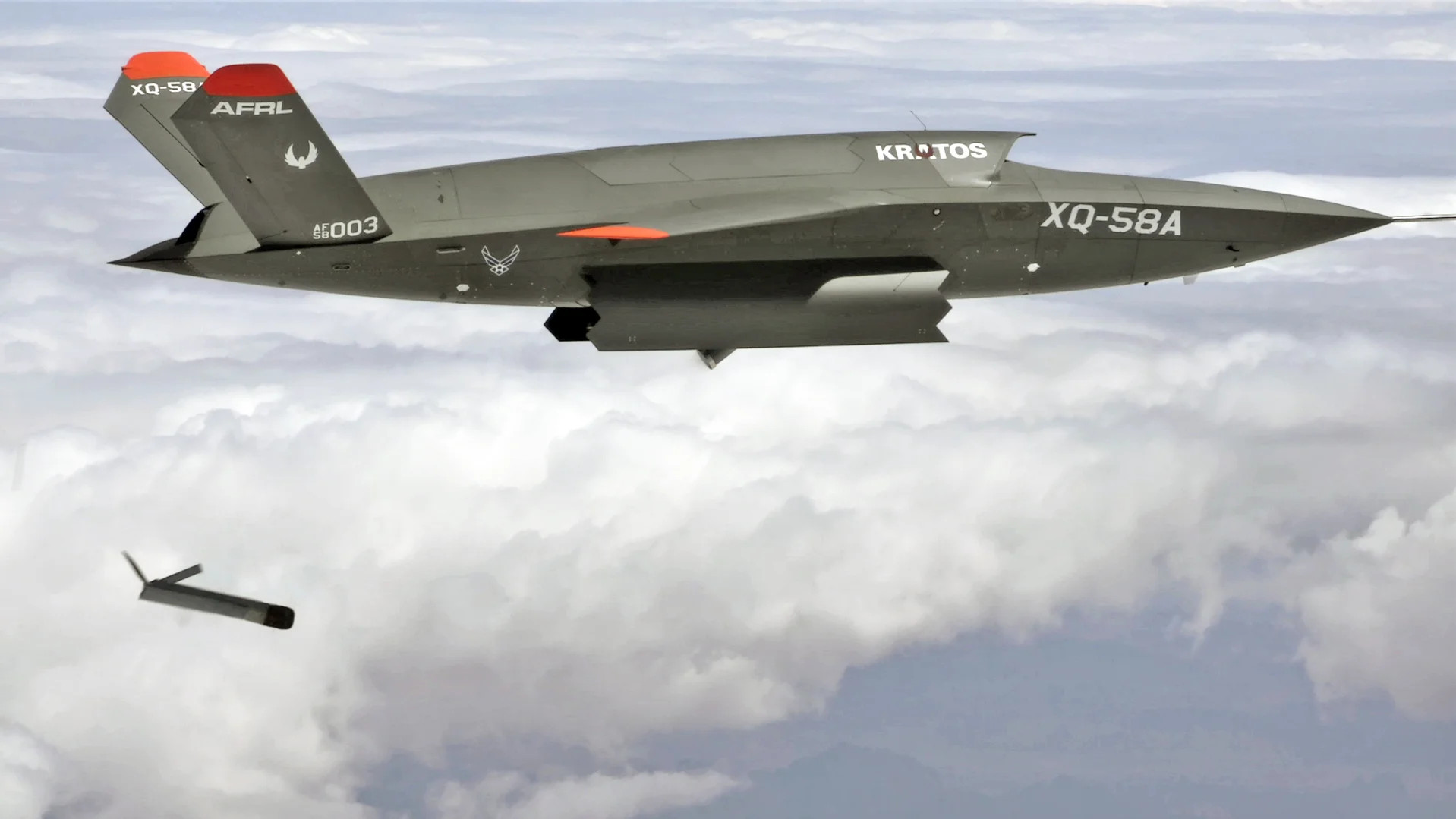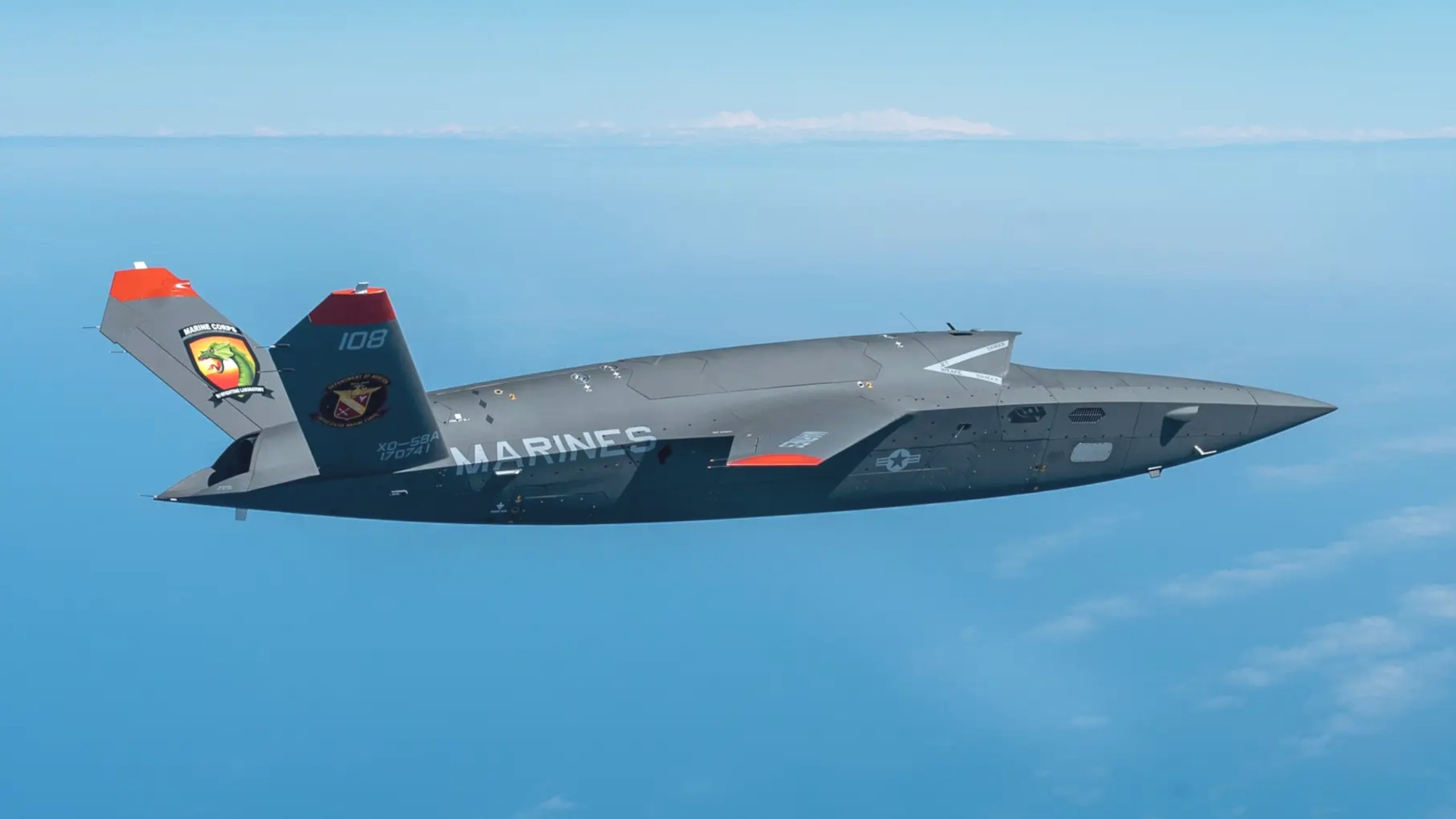Drone maker Kratos says that an MQ-58B variant of its stealthy XQ-58A Valkyrie drone is in development for the U.S. Marine Corps, at least to some degree. The requirements for this previously undisclosed version as they are known now are centered on the ability to launch electronic attacks to suppress enemy air defenses. The Marine Corps’ interest in potentially using the Valkyrie operationally in this role, and in doing so collaboratively with crewed F-35 Joint Strike fighters, has already been front and center in testing involving the service’s small existing fleet of XQ-58As.
Kratos confirmed last month that there were at least five variants of the Valkyrie either in production or development, as The War Zone was the first to report, but made no mention of an MQ-58B version. “M” is the prefix for “multi-mission” in the U.S. military-wide aircraft designation system. The use of “M” rather than “X” for experimental also points to a platform intended for actual operational use.
The mention of the MQ-58B Valkyrie variant was included in a press release that Kratos put out yesterday about a recent test involving a Marine XQ-58A carrying an electronic attack payload. Kratos did not say when that event occurred, but the company’s release included a picture of a Marine Valkyrie flying with a pair of U.S. Air Force F-35A Joint Strike Fighters during a previously announced test flight out of Eglin Air Force Base in Florida on February 23 of this year.

The test flight “successfully demonstrated the ability of the XQ-58A to fly in concert with two F-35 aircraft and the ability to deliver an integrated electronic attack (EA) capability on the XQ-58A Valkyrie,” according to Kratos. “The XQ-58A’s advanced EA payload autonomously detected, identified, and geolocated multiple tactically relevant targets of interest, transmitted emitter target track coordinates to collaborative assets, and successfully presented non-kinetic electronic attack effects against multiple emitters.”
That the February 23 Marine XQ-58A test flight included a demonstration of electronic attack capabilities does not appear to have been previously disclosed.
“The demonstration follows the award of a $22.9M ‘Phase 2′ contract modification on December 4, 2023, for additional engineering development and flight test demonstrations,” Kratos’ release added. It “marks a significant milestone in the PAACK-P program as the Headquarters Marine Corps Aviation Cunningham Group and Advanced Development Team, Marine Corps Warfighting Lab, the Office of the Undersecretary of Defense for Research and Engineering (OUSD(R&E)), the Naval Air Systems Command (NAVAIR), and Naval Air Warfare Center Aircraft Division (NAWCAD) AIRWorks continue to inform MQ-58B requirements for the Marine Air-Ground Task Force (MAGTF) Unmanned Aerial System (UAS) Expeditionary (MUX) Tactical Aircraft (TACAIR) for use in a Suppression of Enemy Air Defense (SEAD) role.”
Penetrating Affordable Autonomous Collaborative Killer-Portfolio (PAACK-P) is the name of the current experimentation program under which the Marine Corps has been testing its small fleet of XQ-58As. PAACK-P is tied to a broader Marine aviation modernization initiative called Project Eagle. The Marine Corps has been flying its XQ-58As from Eglin since October 2023 and is the second known operator of the Valkyrie. The first is the U.S. Air Force, which has been using its XQ-58As to support a variety of advanced autonomy and other research and development efforts since 2019.

What stage of development the MQ-58B might be in now is unclear. The requirements in question may still be largely notional as part of larger Marine Corps efforts to refine its vision for acquiring and fielding advanced uncrewed aircraft in the future, including as part of the MUX program. The War Zone has reached out to Kratos and the Marine Corps for more information.
General interest on the part of the Marine Corps in using drones with electronic warfare suites for the SEAD mission, and potentially the Valkyrie specifically in this role, is not in question.
“Pne mission the Marine Corps’ Valkyries are focusing on includes electronic warfare effects in conjunction with the F-35 [to] strengthen the assault support platforms all under the Penetrating Affordable Autonomous Collaborative Killer program,” Kratos CEO Eric DeMarco said during a quarterly company earnings call in May 2023.
In that same call, DeMacro talked more broadly about a future vision involving “high-performance jet drones with augmented autonomy or if you will, artificial intelligence that can carry weapons, that can do SEAD, that can do DEAD [destruction of enemy air defenses], some of them they can do electronic attack – all types of missions.”
The Valkyrie notably has a demonstrated ability to release stores from an internal payload bay. Kratos has also shown concepts for variants with the ability to carry munitions and other stores under their wings.

Using the stealthy Valkyrie in this role, and conducting those operations in concern with F-35 Joint Strike Fighters that have their own powerful electronic warfare suites, makes perfect sense. This is something The War Zone has highlighted before, including in the following that was written after DeMarco’s comments last May:
“Using a collaborative drone as an associated electronic warfare platform opens up a huge book of new potential tactics and capabilities that will help F-35s survive inside the enemy’s air defense umbrella. The Valkyrie can also launch its own stand-in jammer drones and weapons, and can operate far forward of manned assets even as a decoy. It’s possible that its weapons bay could be converted to fuel and electronic warfare systems, as well.”
“We also know that XQ-58s have been equipped for tests with the F-35’s Multi-Function Data-Link (MADL) which is highly directional and very hard to jam or intercept, so connecting the two seamlessly, just as F-35s are connected, should not be an issue. Even having the drones just relay critical MADL data forward or back over the battlefield in a ‘daisy chain manner’ would be a big advantage for F-35-Valkyrie ops. It would also allow a more resilient data flow, especially in an electronic warfare heavy combat environment and one in which space communications assets will be at risk.”
The networking capabilities described here would allow Valkyries to act as valuable off-board extensions of the F-35’s electronic warfare capabilities. The drones could be sent ahead first into potentially higher-risk environments further helping to improve the survivability of the F-35s, or other crewed platforms, they are working with.

More recently, Marine Lt. Col. Robert “Champ” Guyette, now commander of Marine Fighter Attack Squadron 214 (VFMA-214), also told The War Zone the following:
“The future is lightweight, lower cost distributed and agile. To be more specific, the days of individual monolithic systems present vulnerabilities and exposure that are unacceptable in tomorrow’s fight. When you are trying to take down an SA-20 [U.S. military designation for the Russian S-300PMU-1/2 surface-to-air missile system] or an export surface-to-air missile system, I think we are rapidly realizing that something designed to shoot down fighter planes should not be attacked with fighter planes. It sounds silly when you say it like that but maybe something that is extremely easy to produce or less difficult to produce and something that is difficult to target might be better is a way for us to invert the cost/benefit ratio. What I mean by that is if they shoot an exquisite system at a cheaper blue asset, we are winning if they hit it because an exposure event launched it and the cost event by expending that round. Attacking things designed to shoot down fighter planes with fighter planes is not good business. This thinking is somewhat of a shift.”
The War Zone interviewed Guyette, who previously served as Marine Operational Test and Evaluation Squadron One’s (VMX-1) Operational Test Director, for a multi-part series on that unit and how it is helping to shape the future of Marine aviation. You can find the third installment in that series, the most recent at the time of writing, here.
It is possible, if not very probable that the Marine Corps’ interest in a future operational version of the Valkyrie goes beyond electronic attack and the SEAD mission. The use of the multi-mission MQ-58B designation instead of a more role-specific one like EQ-58B certainly points this way.
As The War Zone has highlighted in the past, the XQ-58’s runway independent design, by itself, is something that would be very attractive to the U.S. Marine Corps and its current focus on expeditionary and distributed operations from temporary bases in remote and austere locations. The Valkyrie uses a rocket-assisted takeoff method to get into the air and lands via a parachute recovery system at the end of a sortie. The operational footprint for the drones overall is relatively small and Kratos has even shown a concept for a completely containerized launch system in the past.

The Valkyrie’s runway independence would also make it easier to pair the drones with short takeoff and vertical landing capable F-35Bs operating from forward locations. Forward basing of F-35Bs is another central aspect of the Corps’ expeditionary and distributed operations plans.
Work on the MQ-58B and other new Valkyrie variants could be of interest to other customers, including the U.S. Air Force. Kratos was notably not among the contractors selected to develop drones under the first phase, or Increment 1, of the Air Force’s Collaborative Combat Aircraft (CCA) program. The company has stated its interest in securing a contract as part of CCA’s Increment 2, which may also be the first phase of the effort to include foreign participation. As already noted, the Air Force is already utilizing XQ-58As outside of the CCA program and could be interested in utilizing additional Valkyrie variants as part of other projects.
For the Marine Corps specifically, the idea of an MQ-58B with electronic attack and potentially other capabilities makes perfect sense. While there is no procurement program of record disclosed at this time, the service could be on a path toward being the first to field an operational variant of the Valkyrie.
Contact the author: joe@twz.com
